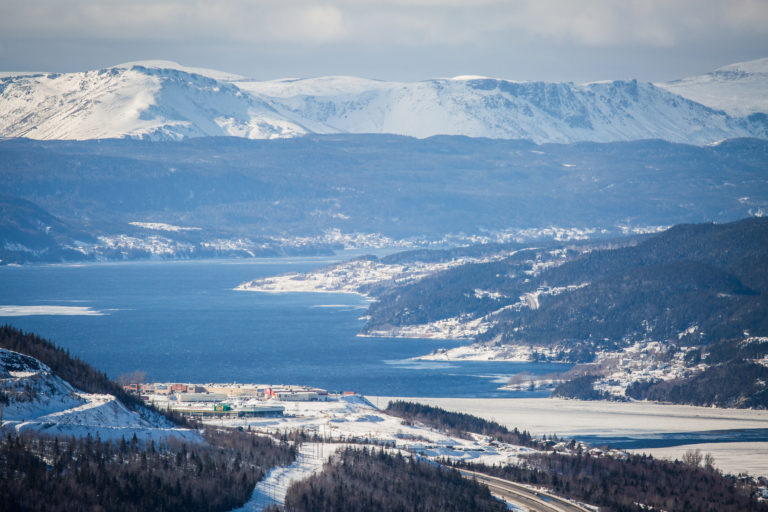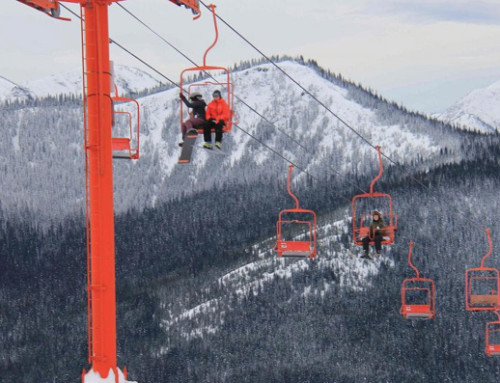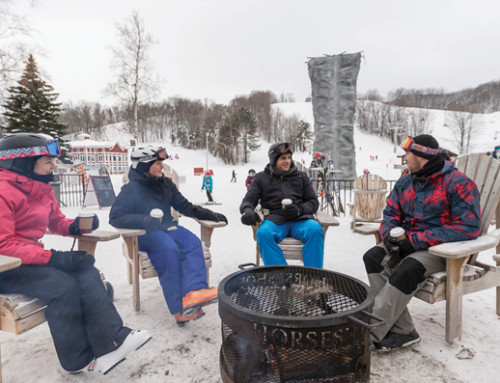BY: Dave Fonda PHOTOGRAPHY: Dru Kennedy
“Here,” Ashley says as she hands me a great, gooey slab of fresh mille-feuille. “You have to try this.”Ten minutes ago, I didn’t know Ashley from Adam. Now we’re best pastry pals, sharing a custard cream at the Enterprise Rental Car counter at Deer Lake Regional Airport, where she works. Ashley’s been telling me about places to see and things to do while visiting the west coast of Canada’s easternmost province, starting with this fine pastry. It’s 1 a.m. I’m jet-lagged. I’m famished. And I honestly don’t know what I’m enjoying more: the conversation, the mille-feuille or this strange moment of “almost awkward friendliness.”
Ten minutes ago, I didn’t know Ashley from Adam. Now we’re best pastry pals, sharing a custard cream at the Enterprise Rental Car counter at Deer Lake Regional Airport, where she works. Ashley’s been telling me about places to see and things to do while visiting the west coast of Canada’s easternmost province, starting with this fine pastry. It’s 1 a.m. I’m jet-lagged. I’m famished. And I honestly don’t know what I’m enjoying more: the conversation, the mille-feuille or this strange moment of “almost awkward friendliness.”
Cole Fawcett, the sales and accommodations manager at Marble Mountain, introduced me to that phrase. An “almost awkward friendliness” is what most CFAs (that’s “come from aways”) feel in the face of Newfie hospitality and charm. Newfies don’t just make you feel welcome and right at home – they’re so incredibly nice, they make you wish Newfoundland were your home. Maybe that’s why so many people are now deplaning the redeye from Toronto. They’re all coming home to this awkwardly friendly and achingly beautiful place; most, it seems, are oil patch workers who can’t stomach being away for more than a two-week stretch. One visit and you’ll understand why.
When Ashley said “you have to try this,” she could just as easily have been talking about sipping an Iceberg beer from the Quidi Vidi Brewing Company, exploring nearby Gros Morne National Park, snowmobiling in the Blomidon (Blow Me Down) Mountains, attending a neighbourly boil up, fly fishing along the Humber River or, my personal favourite, skiing Marble Mountain.
I first skied Marble eight years ago, as the doubly unfortunate Sir Paul McCartney and his then-wife, Heather Mills, debated a feisty Premier Danny Williams on CNN. The M&Ms were doomed the minute they mistook Prince Edward Island for Newfoundland. The much-touted Great Seal Hunt debate was a bloody rout, and everyone I met was overjoyed. Of course, Newfoundland had much to celebrate back then.
The East Coast was gushing with oil, and the western side of the island had become a magnet for wealthy Irish investors shopping for affordable country estates. The Humber River valley was booming with the sounds of mansions springing up. The airport was then called Deer Lake International, and air carriers were offering direct flights to London Gatwick. All that ended when the Celtic Tiger collapsed. Fortunes vanished overnight and, in the aftermath, savvy locals snapped up abandoned palaces and all the treasures therein for a song.
Standing here, chatting with Ashley, I wonder what else has changed since those heady, fat days.
After a great night’s sleep at Marble Villas, Atlantic Canada’s only on-mountain accommodations, I wake to a light dusting of fresh snow under a heavenly blue sky. I dress, click on my skis and skate over to the Marble Mountain Lodge for breakfast. It’s a huge, imposing, painted grey wood affair that was built by an unflappable Corner Brook lawyer turned provincial premier named Clyde Wells.
Inside, its storied knotty pine walls are covered with vintage skis and period black and white photographs. One, dated 1972, shows a young Nancy Green. In her youthful exuberance, Nancy declared Marble the “best skiing east of the Rockies.” Though she’s never stopped disavowing that claim, the fact is Marble serves up some mighty wonderful skiing.
“When the conditions at Marble are on,” Fawcett says, “you won’t find more exciting skiing anywhere in the East. There are bigger mountains with more vertical and way more runs. There are even a couple where you can ski above the tree line. You can’t change that. But I guarantee you can’t find more exciting skiing in the East than Marble. And I’m not even from here!” Fawcett, it should be noted, hails from Poley, New Brunswick, and has spent his entire life skiing Atlantic Canada and New England.
Marble Mountain is thrice blessed, with its bountiful snow, terrific terrain, and zero crowds. On average, more than 500 centimetres of deliciously dry snow falls here every winter. According to Keith Cormier, Marble’s resident historian emeritus, “It snows when warm, wet air from the Gulf of Saint Lawrence hits the cold, dry mountain air of Western Newfoundland. The snow is dry, even though Marble is just a hair and a wink above sea level.”
Then there’s the terrain. Marble is Atlantic Canada’s biggest peak with 519 vertical metres, 230 acres of skiable terrain and 39 trails. While those numbers ordinarily spell mid-size, there’s nothing ordinary about Marble. It skis BIG.
“Marble is a skier’s mountain,” Cormier says. “That entails two things. First, there’s the love of skiing, of being a skier. Marble Mountain feeds that by serving up everything skiers love about skiing. Then there’s the love of being on the mountain. Most skiers ski because there’s more to skiing than skiing.” At Marble, that includes everything from drinking in the gorgeous vistas of the Humber River valley to drinking Screech and Old Sam in the Knotty Pine Lounge, where the après-ski can range from lively to legendary.
Which brings us to Marble skiers. Though few in number (weekdays, no one skis here), many are seriously good. They’re the products of a terrific ski school and racing club, of a remarkable can-do attitude in which friends and family constantly challenge each other, and of a rich and vital ski culture that’s nudging the century mark.
Skiing came to Western Newfoundland in the ‘20s, when the Newfoundland Power and Paper Mill first opened in nearby Corner Brook. The mill needed skilled woodworkers, so it recruited them from Scandinavia.
“The Scandinavians brought their skis and introduced Nordic and X-C skiing here,” Cormier says. “They even built a ski jump in Corner Brook.
“The Bowaters took over the mill in 1936, and their senior management was very community oriented,” he adds. “Many served as presidents of the Corner Brook Ski Club that were established to develop skiing in the area. They cut their first alpine trail at Massey Drive in the late ‘30s. They developed the first hill and the first lodge. It was all hike and ski back then.”
In the late ‘50s, the club began scoping a new hill. The selections were narrowed down to Marble, Blomidon and Hughes Brook. Three former club presidents were tasked with selecting the winner. Each voted for their favourite. “Marble won on account of the president who voted for it voted twice,” Cormier says.
Marble opened with one trail in 1961. The Corner Brook Ski Club went on to introduce lifts, including a rope tow with a jury-rigged tow truck that lasted until the mill foreman took the rope back to the mill. What followed was one for the books.
“Bowater acquired these newfangled chainsaws and set about testing them on Marble Mountain, which it then owned,” Cormier says. “Bowater first cut the wood to make new ski trails from the top. Next, it donated the wood to the Corner Brook Ski Club. The club then sold the wood back to Bowater. Kevin St. George, who was then club president, took the $15,000 (a handsome sum in 1960s dollars) that Bowater paid for the wood and invested it back in the club.”
It’s enough to make you wonder how much richer the world would be if we could all practice a little Newfie generosity and know-how.
Marble was a favourite getaway among servicemen at the U.S. Air Force base in Stephenville until the base closed in 1966. Over the next several decades, Marble would continue to grow, acquiring new lifts, cutting new trails, forging new ground. In those days the mountain was entirely managed by volunteers. (The province now runs it.)
After a delicious breakfast of bacon and eggs served up by the charming “What’ll-it-be-darlin?” Colleen, I ride the Governor’s Express quad to the summit. Disembarking, I count more Yamaha and Ski-Doo jackets than Bogners and Descentes. I pause to survey the Governor’s Balls, two massive boulders nestled below the Doppler Weather station that tower over the summit.
Despite the abysmal non-winter the East has endured, the snow conditions are astonishing. It must be the Marble effect. Dipping down a blue named Chilliwack, both my skis and I are delighted to find fabulously fresh and forgiving snow free of the icy patches, rocks and bare spots we’ve experienced all winter. I stop at the top of L’Anse aux Meadows and drink in the stunning view of the Humber River and the rooftops of Steady Brook. The surrounding mountains recede like frozen white caps as far as the eye can see. Gee, but it’s good to be back home.
Marble hasn’t changed much since my last visit. The terrain is still predominantly intermediate and expert. Only one green, the aptly named Country Road, reaches the top. The grooming still maximises skiing pleasure rather than skier traffic. The chairs still run smoothly, and the lift attendants and chalet staff are as friendly and helpful as ever. The biggest difference I’ve noticed so far is in the Cookhouse, where fried squid (calamari fritti, if you will) is no longer on the menu.
During my too-brief stay, I learn that dining has improved considerably in Western Newfoundland. Back then it seemed that everything was raw, deep-fried or boiled. Tastes have clearly changed.
Across the highway in tony Steady Brook, Madison’s serves up mighty fine classic Continental and Newfoundland cuisine, including house-cured charcuterie and a chicken and seal sausage roulade. Down the road in Corner Brook, Newfound Sushi (see sidebar) has been wowing local foodies with fabulously fresh sushi since 2012. Local photographer and snowboard phenom Dru Kennedy swears it’s the best sushi east of Vancouver. You’ll get no argument here. Not when Dru’s paying.
It’s surprising how quickly you can get over that almost awkward friendliness.
From Snowboards to Sushi
Before launching Newfound Sushi, master chef Kevin Vincent was best known as Marble Mountain’s snowboarding pioneer. Way back then, two fledgeling companies named Burton and Sims had just launched their throwback models, which looked like small wooden surfboards attached to toboggan cords. Unable to procure one locally, Vincent built his own. It died its first day on snow.
Vincent’s second board was way stronger. It also weighed 40 pounds. Undaunted, Vincent kept at it and eventually landed a ski industry job out West. While there he met his bride-to-be, Andrea, who introduced him to sushi, which he hated. Proving once again that love conquers all, Vincent learned to love sushi by teaching himself how to make it. He began showing off his culinary creations at house parties. Eventually, the couple married and returned to Corner Brook.
One day, a local grocer sampled Vincent’s sushi skills at a party and hired him on the spot to supply his supermarket. Vincent’s sushi was so popular that in 2012 he and Andrea opened their own restaurant. Newfound Sushi became the hottest ticket in town, especially among Corner Brook’s young university crowd. Says one wag, “older Newfies won’t try it unless you boil it, fry it, toss out all the flavours and then smother it in gravy!”
Apart from the unagi (roast eel), virtually all the fish Vincent serves is caught in Newfoundland, most of it within 100 miles of his restaurant. Finding a seat at Newfound Sushi can be difficult, never mind a table. There are just four tables, 14 chairs and four seats at the sushi bar. Construction has already begun on an izakaya or Japanese bistro upstairs.
















